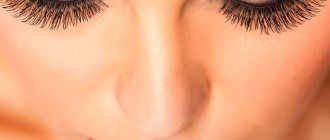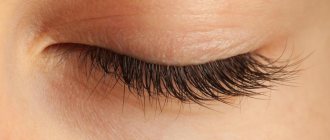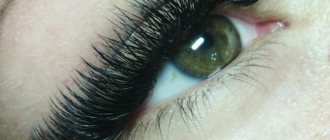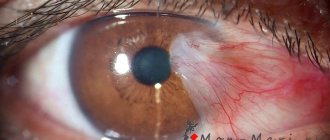Today, more and more often you can meet girls with a charming and bewitching look thanks to eyelash extensions. But often, representatives of the fair sex ask for help on forums, asking the question: “After eyelash extensions, my eyelids are swollen, what should I do?”
Causes of eyelid swelling after eyelash extensions
You need to approach eyelash extensions very responsibly, choosing a reliable salon with experienced professionals.
If your eyes are swollen after eyelash extensions, the reasons may be the following:
- An allergic reaction to the glue used in extensions, which contains many unnatural components. This is the most likely factor causing swelling of the eyelids, the distinctive features of which are itching, redness and lack of pain;
- The infection leads to inflammation, accompanied by swelling and pain. This happens as a result of non-compliance with sanitary and hygienic standards: lack of or poor-quality sterilization of instruments, treatment of the master’s hands with antiseptic solutions;
- Accidental, careless movement of instruments can lead to mechanical injuries to the skin of the eyelid and retina. This will lead to serious complications. Therefore, it is not recommended to carry out such work on your own at home;
- Use of cheap, low-quality materials;
- The body rejects the foreign body.
Whether the extension was successful or not will become clear a few hours after the procedure. When something goes wrong, the body will immediately show the first alarming symptoms.
Important! If your eyes become swollen after eyelash extensions, or redness of the eyelid or eyeball appears, you should immediately consult a doctor. The inflammatory infectious process can cause serious harm.
Can you be allergic to eyelash extensions?
Any chemicals used in the beauty industry can cause a negative reaction in people with hypersensitivity. It is possible to be allergic to eyelash glue, even though self-respecting, experienced eyelash technicians use high-quality hypoallergenic compounds.
Types of glue:
- Rubber (the main component is latex powder). Thick, holds well, but sets slowly and often causes allergies.
- Glue resin. Reliable, most natural, but takes a long time to dry and roll off. Provokes a reaction in women with sensitive eyes.
- Rubber – made from rubber processed in a special way. Hypersensitivity is rare.
- Silicone is transparent and has hypoallergenic components.
Each component contained in eyelash extension glue is potentially dangerous for allergy sufferers. It is perceived by the body as foreign. A protective immune reaction is activated, which is why immunoglobulin E and the mediator histamine are synthesized in large quantities. They cause capillaries to dilate. Redness of the mucous membranes of the eyes, lacrimation, itching and other allergic symptoms occur.
More often than others, cyanoacryl provokes a reaction. Its vapors irritate the mucous membranes of the nose and eyes. Professionals in the salon are especially susceptible to the effects of the substance, since due to their occupation they have to constantly breathe harmful fumes.
A powerful irritant is formaldehyde, a toxic compound that unscrupulous manufacturers add to adhesives. Formaldehyde is usually included in the formulation of inexpensive products supplied from Southeast Asia.
The glue comes in transparent and black. Black is more likely to cause a reaction because it contains dyes. It is also not at all a fact that these dyes are of high quality and hypoallergenic.
Natural eyelashes (from mink) are usually used for the procedure. But some girls, wanting to save money, agree to synthetic eyelashes. They can also become a source of discomfort.
It happens that an allergy to eyelash extensions is not associated with low-quality materials. Perhaps the storage conditions were not followed. Or the composition has expired and has become dangerous to eye health.
Factors that increase the risk of developing allergic symptoms:
- Hereditary predisposition. Children of parents with allergies are more likely to suffer from this pathology.
- An existing allergy to something.
- The presence of acute or chronic conjunctivitis.
- Increased sensitivity of the skin of the eyelids.
There are often situations when extensions are done not in a salon, but independently at home. In this case, the glue is sometimes applied directly to the eyelids, although there are clear instructions that it should be applied to the eyelashes. The result is allergic symptoms.
Symptoms
Swelling after eyelash extensions is accompanied by the following symptoms:
- Swelling of the eyelid;
- Redness of the skin;
- Burning and itching;
- Soreness;
- Increased tear production.
If one of the signs of poor-quality extensions or allergies appears, you must carefully remove the eyelash extensions, consult a doctor to accurately determine the cause and, based on this, select an effective treatment regimen.
Why do your eyelids itch: mistakes made by extension specialists?
Yes, and this is also one of the most common reasons that can cause you discomfort after transforming your appearance.
Technical violations may be as follows:
- The appropriate indentation from the edge of the eyelid is not observed . In this case, the artificial hairs will scratch the skin when blinking and irritate it. This distance should be 0.5 mm. You can verify that a violation has occurred after the procedure: when you close your eyes tightly, you will experience a tingling sensation in your eyelids. In this case, correction of the extension is necessary, since systematic trauma to the skin can cause swelling and dermatitis.
- Eyelashes have glued together . Itching occurs especially often if an artificial eyelash was attached to two real eyelashes that are in different phases of growth. At the same time, one of them continues to grow, while the other is in the resting phase. Then itching may appear, and after a certain time after the procedure. This problem can also be solved by getting it corrected by a more experienced and attentive specialist. And you can read more about what growth phases our eyelashes have in the article “Do eyelashes fall out after extensions?”
- Wrong size. If the artificial hairs are too long or thick, and your eyelashes are not able to withstand the load, then sagging occurs. In this case, the root of the real eyelash takes an unnatural position inside the follicle; in order to hold it, an increased contraction of the muscles holding the root is necessary, and this causes itching. In addition, such a violation is fraught with loss of eyelashes, since over time it loses its ability to stay in the bulb.
- Sometimes the cause of mild itching is irritation from patches that protect the skin of the eyelids from accidental contact with glue. In this case, the itching may go away on its own when the protective pads are removed. Occasionally, an allergic reaction to the material from which the applicators are made occurs, depending on the severity of the symptoms, the use of medications, such as skin soothing cream or allergy medications, may be required. Such situations occur extremely rarely if the procedure was carried out by a highly qualified specialist and hypoallergenic auxiliary materials were used.
Treatment of swelling after eyelash extensions
Therapy for edema is prescribed only by an ophthalmologist; the following drugs are most effective:
- The body's toxic-allergic reaction to an irritant can be relieved by Opatanol drops. You need to put 1-2 drops in your eyes 2-3 times a day for a week.
- Dexamethasone drops, which have anti-inflammatory and antiallergic properties, help well, but they are recommended to be used only in consultation with a specialist and strictly in accordance with the instructions.
- Polynadim drops can cope with allergic and infectious edema; they should be used 3 times a day for 7-10 days.
- Antibacterial drops Ofloxacin or Oftaquix can quickly and effectively combat the infection; it is recommended to instill swollen eyes 4 times a day. Before going to bed, lubricate the eyelids with Floxal eye ointment, continue treatment for at least 7 days. To improve the effect, rinse your eyes with furatsilin (2 tablets per 250 ml of water) 3-4 times a day.
- If the eyelids are swollen enough, a burning sensation and itching appear in combination with the antihistamines Polinadim, Lecrolin, Hydrocortisone eye ointment is used. Treatment should be carried out for at least 5 days.
When using two types of drugs in therapy, a break of 30 minutes should be taken between them.
After swelling, you need to wait at least 2-3 months before the next eyelash extensions. Before the procedure, be sure to inform the specialist about a possible allergic reaction to the materials so that she can extend eyelashes using hypoallergenic glue, and then nothing will spoil your beauty. If the allergy recurs, the extension procedure will have to be abandoned.
Treatment with folk remedies
To speed up the healing process, you can supplement treatment with alternative medicine recipes:
- If your eyelids are swollen from eyelash extensions, you need to make juice from fresh potatoes, moisten cotton pads, and gently apply to the inflamed eyelids for 5-7 minutes. After this, lubricate the eyelids with nourishing cream.
- Apply fresh cucumber gruel to swollen eyelids, repeat the procedure 3 times a day for 7 minutes. This will help you quickly and effectively cope with swelling.
- Brewing strong tea will help with swelling after extensions; you need to do compresses 4-5 times a day.
- A mixture of chamomile flowers and oak bark, one tablespoon each, brew with boiling water, leave, let cool. Make ice cubes from the broth, wrap them in a cotton towel and wipe the inflamed eyelids 4 times a day.
- A decoction of mint and lemon balm (1 tablespoon each) will help effectively eliminate swelling and irritation.
- Apply a mixture of chopped parsley leaves and sour cream in 1:2 parts for 15 minutes. This stimulates regeneration, helps fight swelling, moisturizes and nourishes the affected area.
- Chopped carrots and parsley root are thoroughly mixed, and the paste is applied for 15 minutes.
All recipes speed up the recovery process, stimulate regeneration and relieve painful symptoms.
Treatment of inflammation
Many women complain that after a cosmetologist their eyes become swollen or puffy. At the first signs of the disease, you should consult an ophthalmologist. Eyelash extensions should be removed and compresses applied to the eyes. The doctor will select individual medications that will help remove swelling, eliminate the inflammatory process or allergies. You can also relieve inflammation at home using traditional methods.
Medicines for illness
The drops will relieve inflammation.
Visin drops are used as first aid; they relieve burning and help restore the mucous membrane. Albucid or Levomycetin are taken against inflammation. A group of drugs in the form of drops work to reduce the allergic reaction, relieve discomfort and redness. These include:
- "Vitabact";
- "Suprastin";
- "Okomistin";
- "Tobradex";
- "Opatanol".
Traditional methods
Chamomile is a powerful natural antiseptic.
If the eyelids are swollen, a compress of strong black tea, which is applied to the eyes and held for 5 minutes, will help relieve the unpleasant sign. In the same way, lotions are made with apple, potato or cucumber juice. The components are finely rubbed, sponges are dipped in juice and applied to the swelling. Use a tincture of oak bark and chamomile. The recipe is as follows:
- The herbs are brewed and then frozen.
- Use ice cubes to remove swelling.
The swelling goes away thanks to a mask of sour cream and parsley. This mixture lasts for 5-10 minutes and improves blood circulation.
Prevention
To prevent swelling, during eyelash extensions you must strictly follow the rules and recommendations of the specialist:
- Keep your eyes closed throughout the procedure.
- Try not to move your cheekbones or talk, as this can cause your eyelids to tremble and glue to get into your eyes.
- Avoid water treatments for 24 hours to allow the glue to dry completely.
Much in the prevention of eyelid swelling after eyelash extensions depends on the professionalism of the artist:
- It is necessary to correctly calculate the length of the eyelashes, glued too close to the eyelid, it will tingle and irritate the eyeball.
- You cannot glue one artificial eyelash to two natural ones. After this, the eyelid may swell, causing discomfort and irritation.
- In a hurry or through negligence, the master may use more glue than necessary, this will lead to an allergic reaction.
The extension procedure should be carried out by a qualified specialist with certificates; find out reviews about his work before the procedure. And in the case of swelling of the eyelids after eyelash extensions, it is important to determine the cause and adequate treatment. Be healthy and beautiful!
Allergy symptoms
Allergy to eyelash extensions occurs almost immediately after completion of the cosmetic procedure. It is important to know how it manifests itself. This will help distinguish it from other diseases and choose the right effective treatment.
How does an allergy to eyelash extensions manifest?
You can talk about an allergy to eyelash extensions if a woman has swollen eyelids or is bothered by:
- hyperemia (redness) of the eyelid and/or eyeball,
- lacrimation, nasal discharge,
- sneezing,
- itching,
- burning,
- dryness, flaking of the skin,
- swelling of the soft tissues of the face (in severe cases, the entire upper part of the face, areas around the nose and lips swell),
- high body temperature, weakness.
Important! If you are allergic to eyelash extensions, pain in the eyelid area does not occur. The pain syndrome that appears is evidence of an incorrectly performed cosmetic procedure. It will not be possible to eliminate it with antiallergic drugs.
You can also talk about the unprofessionalism of a cosmetologist in the case when unpleasant allergy symptoms do not go away even after removing the hair extensions. In such a situation, it is recommended to seek help from an ophthalmologist.
In what cases should you consult a doctor?
If characteristic symptoms appear, you need to remove the artificial eyelashes. If the swelling on the eyelid has not subsided, you should visit an ophthalmologist. If there is significant swelling, call an ambulance. It is especially important to consult a doctor if the swelling of the eyelid is accompanied by the following unfavorable signs:
- Angioedema angioedema. This is an acute reaction to an allergen. Accompanied by a sharp increase in volume of the eyelid area. Puffiness often spreads to neighboring areas. There may be difficulty breathing. A dangerous complication is anaphylactic shock.
- Impaired vision clarity.
- The occurrence of inflammation, the appearance of purulent contents in the eye.
- Pathological signals that do not pass for more than 48 hours.
What are the symptoms of allergic edema?
- Discomfort around the eyes;
- Redness of the skin of the eyelids;
- Swelling;
- Burning;
- Increased tear production;
- Discharge from the eyes in the morning.
If such symptoms appear, do not delay and consult a doctor, otherwise the situation may result in serious eye problems or even loss of vision. Most likely, you will be immediately recommended to remove your eyelash extensions and will be given treatment consisting of medications and compresses.
How to cure swollen eyes: folk remedies
In order to get rid of eyelid swelling, you need to understand the cause. If this is swelling caused by the lack of makeup remover before bed, then simple lotions made from tea bags will be enough.
How to cure swollen eyes, folk remedies:
- You can cope with swelling with cucumber. Cut a few circles and place them on your eyelids. It is best if the cucumber comes from the refrigerator. Keep the compress for 15 minutes.
- Soak regular tablespoons in cold water and place in the freezer. Remove cutlery from the freezer and place it on your eyelids. After 10 minutes, remove the spoons and you will see that the swelling has become much less.
- Use decoctions of medicinal herbs. Sage, chamomile, and calendula will do. Based on these herbs, decoctions are prepared, cotton pads are soaked in them and applied under the eyes for a third of an hour.
Of course, it is most difficult to get rid of swelling if it is caused by chronic illnesses. In this case, without eliminating the underlying cause, the swelling will not go away. Therefore, if there are problems with hormonal levels, disorders of the thyroid gland, as well as kidneys, it is necessary to treat them.
Edema










